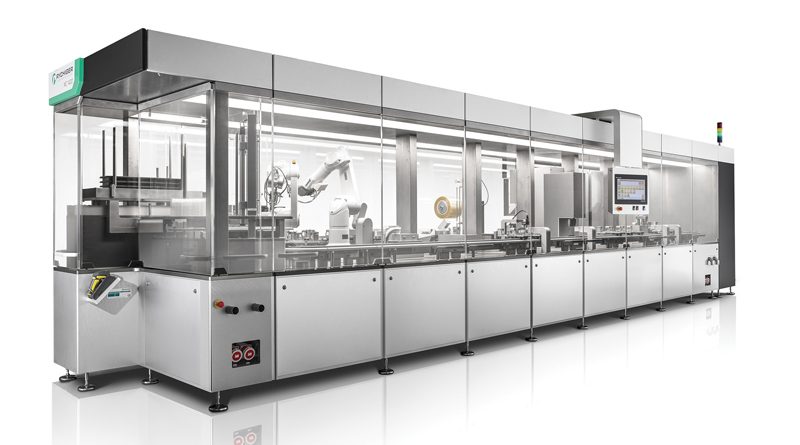Healthcare: the Cartridges Process Is Automated
Rockwell Automation supported an end user specialized in diagnostics and syndromic infectious testing in winning its challenge: automating its single-use testing cartridges process, reducing contamination to an absolute minimum
Thanks to modern reagents and automated analysis technology, diagnostics and syndromic infectious testing (SIDT) have made significant advances over the last few decades, allowing rapid disease identification and life-saving treatments to begin earlier based on laboratory results. A company specialize in diagnostics and SIDT, relied heavily on manual processes to manufacture its single-use testing cartridges – closed-system disposable modules that contains all the chemistry required to isolate, amplify and detect nucleic acid from a patient’s sample for IVD testing. With any manual fabrication process there is the possibility for contaminants to be introduced, and it also influences fabrication quality, repeatability and yield. Thus, the company approaches Switzerland-based Rychiger, a specialist in fabrication of customer-specific solutions for packaging machines in the healthcare, food and beverage industries.
The machine is designed around the independent cart technology
The end user’s goal was to fully automate the cartridge fabrication process, while reducing contamination to an absolute minimum. As did Rychiger, the company had already experience of automation solutions from Rockwell Automation, and of the MagneMotion® independent cart technology (ICT) too. As a result, the two companies agreed that the new machine should be designed around the MagneMotion ICT due to the flexibility, accuracy and repeatability it offers for a demanding multi-stage assembly process such as this. Rychiger’s customer needed a solution to make it easier to move light loads, like its cartridge components, while maintaining full track-and-trace capabilities and faster cycle times. More precise control and intelligent motion could optimize assembly efficiency and speed while helping to eliminate disruption. With fewer moving parts than conventional systems, MagneMotion could result in less maintenance and downtime.

Smoothing the entire traffic flow
The MagneMotion system, using precision rails, delivers accuracy and flexibility in automation environments that require increased speed and decreased downtime. Its multiple independent movers effectively create a “pitchless” conveyor system. This solution smooths the entire traffic flow by doubling up – or in this case tripling up – on the slowest process, which means the system is no longer held back by the slowest stage of the cartridge assembly process. According to Christian Sigrist, senior automation engineer at Rychiger: “At the forefront of our mind when we design and build machines is the ability to both scale and adapt/upgrade the technology. Our wide deployment of an integrated servo-based system – including the MagneMotion ICT solution – makes this significantly easier. It helps for maintenance too, as we can take a station offline and keep the machine running with little impact on production”.

Accessing to all parameters from a centralised location
In addition to the MagneMotion system, the MC 1400 machine Rychiger developed has multiple servo axes, all driven by Allen-Bradley® Kinetix® servo drives, two Allen-Bradley VersaView® 5200 thin clients and FactoryTalk® View SE SCADA software. All station-specific HMIs are managed by the Rockwell Automation ThinManager® software, which centralises information and data, as well as offers remote/mobile access. “ThinManager helps the customer maintain the machine, delivering an overview and access to all parameters from a centralised location” Sigrist adds. “It is especially useful where multiple HMIs are involved. Using a centralised HMI server also aided us in the design and development of the interactivity and control systems”. Overall control of the machine, including the integration of third party Staubli robots, is handled by an Allen-Bradley ControlLogix® L8 programmable automation controller (PAC), with an Allen-Bradley GuardLogix® L7S PAC delivering the necessary safety functionality. All primary communication is via EtherNet/IP™, using Stratix® 5400 and 5700 switches. The main reason for the deployment of the Stratix managed Ethernet switches was so the machine could be tightly integrated into the customer’s network for security, safety and compliance reasons. It also fitted its requirements for CPwE (Converged Plantwide Ethernet).
A solution that keeps operators away from the cartridges
To counter the contamination challenge, the machine is enclosed – which keeps operators away from the cartridges. In addition, the enclosure is also “shadowless”, thanks to an advanced lighting solution, which delivers well-lit visibility to all aspects of the internal elements for cleaning. Moreover, all internal surfaces have been designed to be easy to wipe, with minimal trap points and voids.

